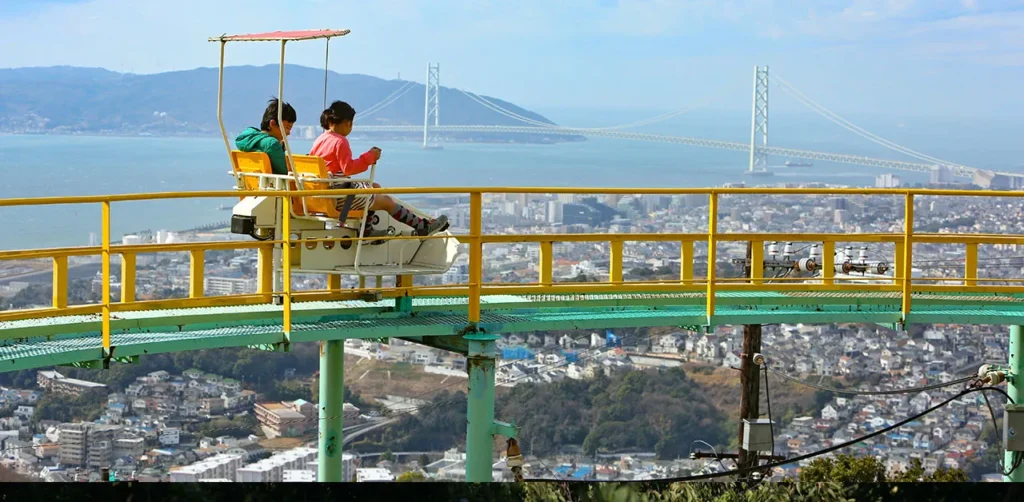神户
神户拥有精致的海港区、可欣赏夜景的群山、充满异国风情的街道,甚至还有著名的温泉胜地等众多风景等着您去体验。
相关文章
-

神户・须磨浦三条游乐园|复古游乐设施、濑户内海美景、壮丽樱花
你听说过神户的须磨浦三条游乐园吗?这个充满怀旧气息的游乐园最近在社交媒体和媒体上人气飙升。它或许没有尖端科技或高科技设施,但却拥有令人怀旧的游乐设施、刺激的游乐项目以及其他地方难得一见的绝美景色。在须磨浦三条游乐园,你可以体验到仿佛穿越回昭和时代的奇妙感觉。<目录> 1. 什么是须磨浦三条游乐园? 2. 须磨浦三条游乐园的交通指南 3. 须磨浦三条游乐园的优惠门票 4. 游览须磨浦三条游乐园的三大理由:・须磨浦三条游乐园的特色游乐设施 ・空中自行车单轨列车 ・可欣赏全景的旋转咖啡厅“Kissa Cosmos” 5. 须磨浦三条游乐园观景台的景色 6. 须磨浦三条游乐园周边推荐景点:・神户须磨海洋世界 ・神户须磨利休公园 须磨浦三条游乐园于1959年开业,是一座迷人的复古风格游乐园,坐落于山顶。游客可乘坐索道、独特的“Car-later”自动扶梯和观光电梯到达山顶。在那里,您可以体验到许多充满怀旧乐趣的项目,包括自行车单轨列车、迷你汽车乐园和儿童游乐区。公园内设有烧烤区和罕见的旋转观景塔,提供丰富多彩的娱乐活动。从公园可以欣赏到濑户内海的平静景色,以及明石海峡大桥和淡路岛的迷人风光。前往须磨浦三条游乐园可乘坐火车。〇从大阪/神户三宫出发:从阪神铁道大阪梅田站乘坐开往姬路的特快列车至山阳须磨站,然后换乘普通列车在须磨浦公园站下车。公园入口就在车站外。〇从明石/姬路出发:从山阳铁道乘坐开往阪神梅田的特快列车至山阳垂水海站,然后换乘普通列车在须磨浦公园站下车。公园入口就在车站外。从须茂浦公园站出发,您需要乘坐一系列交通工具才能到达山顶的须茂浦三条游乐园:缆车(约3分钟)→汽车(约2分20秒)→观光电梯(约4分15秒)。我们推荐您使用阪神山阳海滨一日通票游览须茂浦三条游乐园。这张便捷实惠的通票允许您在阪神铁道大阪梅田站/大阪难波站和山阳铁道山阳姬路站之间无限次乘坐游乐设施。此外,我们还推荐您在游乐园内购买“须茂浦三条游乐园往返优惠票 - A套餐”。这张往返票包含缆车、汽车、观光电梯以及观景塔的门票。・成人(初中生及以上):2,100日元 ・儿童(小学生):1,600日元 *学龄前儿童免费入场。让我们为您介绍游览须茂浦三条游乐园的三大不容错过的亮点。前往须茂浦三条游乐园,您需要换乘三项精彩刺激的游乐设施。从第一段缆车开始,全程至少需要60分钟,通常约为90分钟,如果您想放慢脚步,尽情享受,则可能需要长达120分钟。您的旅程从与山阳铁道须茂浦公园站直接相连的缆车开始,缆车每15分钟一班。从缆车车窗,您可以欣赏到壮丽的海景和天空景色,以及沿着海岸线行驶的列车。接下来,您将乘坐连接缆车山顶站和公园内山顶的“车厢”(Car-later)。这种在日本其他地方难得一见的游乐设施,因其篮状外观和著名的“颠簸之旅”而备受喜爱。它剧烈摇晃,缓缓攀升约25度的陡坡。凭借其独特的角度和震动,这91米长的游乐设施充满刺激。最后,您可以登上观光电梯。电梯以舒缓的速度轻柔摇晃,您可以一边欣赏美景,一边享受清爽的微风和悠闲的漂浮感,度过一段平静愉悦的空中漫步。须茂浦三条游乐园的必玩项目是自行车单轨列车。这项游乐设施将您带入一辆双人脚踏车,沿着离地3-8米的轨道行驶,环绕一周。它老少皆宜,票价为每次300日元。尽情享受独特的漂浮感和刺激——仿佛在空中滑翔。晴朗的日子里,您可以饱览明石海峡大桥和淡路岛的壮丽景色。樱花盛开的季节,您甚至可以乘坐观光列车穿过横跨轨道的樱花隧道,体验梦幻般的春日之旅。须磨浦三条游乐园里,您绝对不容错过的景点是旋转观景塔,它就位于观光电梯的出口处。三楼的Kissa Cosmos是日本为数不多仍在运营的旋转餐厅之一。圆形的地板大约55分钟旋转一周。您可以一边品尝饮品或享用简餐和甜点,一边放松身心,欣赏360度的全景。强烈推荐蜜瓜苏打和奶油苏打,在夕阳的映照下,它们显得格外美丽。咖啡馆原创设计的杯垫也十分可爱——可爱到您一定会想带一个回家。公园内设有多个观景台,每个观景台都拥有各自独特的壮丽景色,从360度全景到独特的周边景观视角,应有尽有。〇 东展望台 位于缆车旁的Car-Lator车站屋顶,这个观景台可以俯瞰美丽的须磨海岸线。即使等待返程缆车,也能欣赏到如此美景,令人心旷神怡。〇 旋转展望台屋顶观景台 旋转展望台屋顶的景色令人叹为观止,被评为“兵库县150个最佳观景点”之一。晴朗的日子里,甚至可以看到关西国际机场。这里也是元旦观赏日出的热门地点。〇 西展望台 西展望台是观赏世界最长悬索桥——明石海峡大桥的绝佳地点。附近设有休息区,是享用自带午餐、欣赏美景的理想场所。 〇 从畑利茶屋 (Hatahuri Chaya) 眺望 从须磨浦三条园 (Sumaura Sanjo Yuen) 再往上走一点,畑利茶屋 (Hatahuri Chaya) 也能欣赏到绝美的景色,绝对值得您花上一小段路程。须磨浦公园也是兵库县最著名的赏樱胜地之一。春天,公园内约有 3200 棵樱花树竞相绽放。您可以拍摄樱花环绕的海景,也可以乘坐观光缆车欣赏漫山遍野的粉色樱花——这是须磨浦三条园独有的体验。在神户须磨海洋世界 (Kobe Suma Sea World),您可以观赏到各种海洋生物,包括虎鲸和海豚,这里还有日本西部唯一的虎鲸表演。虎鲸和海豚表演都充满活力,精彩刺激,以美丽的须磨海滩为背景。虎鲸表演时,强劲的水花可能会溅到观众席上,所以如果您想感受震撼的场面,一定要坐在前排。在蓝海虎鲸体育场餐厅,您可以一边用餐一边欣赏虎鲸,品尝以兵库县当地食材烹制的美味佳肴。这家餐厅非常受欢迎,因此我们建议您在确定旅行日期后尽早预订。神户须磨利休公园是一座大型城市公园,建于昔日皇室别墅——向光利休的旧址之上。公园分为西式园林风格的主庭园和植物园,游客可以在植物园欣赏玫瑰、鸢尾花、梅花等时令花卉。游览神户须磨利休公园的最佳时间是5月中旬至6月中旬,届时约有300个品种、4000株玫瑰盛开;以及10月初至11月中旬。秋季红叶的最佳观赏期通常在11月中旬至12月初。在此期间,公园会举办特别的灯光秀和照明活动,让您在色彩斑斓的红叶丛中漫步,享受惬意时光。从大阪出发,只需约40分钟车程即可抵达神户须磨地区,交通十分便利。如果您想远离都市的喧嚣,何不前往这座充满复古情调、自然风光旖旎的游乐园呢?这里有各种各样充满魅力的游乐设施和景点,让您尽情释放童心;周围环绕着郁郁葱葱的greenery和蔚蓝的大海,定会让您身心焕然一新。
-

淡路岛交通指南:从大阪、神户和明石出发
兵库县的淡路岛拥有众多景点,从风景优美的观景点和美味的当地美食,到“二次元之森”和“淡路梦舞台”等热门景点,以及“快乐煎饼”等海滨咖啡馆,应有尽有。从大阪或神户出发,一日游即可轻松抵达。您也可以从关西地区的多个地点租车自驾前往,但本文将介绍如何乘坐公共交通工具前往。我们将重点介绍从大阪和神户前往淡路岛的交通方式,特别是高速巴士,并提供行程时间和票价信息。<目录> 1. 从大阪难波前往淡路岛 2. 从大阪梅田前往淡路岛 3. 从神户三宫前往淡路岛 4. 从明石乘坐渡轮前往淡路岛 5. 前往淡路岛的要点 从难波前往淡路岛有两种方式:乘坐直达高速巴士或换乘火车和巴士。乘坐巴士:高速巴士可从JR难波站港町巴士总站出发,由西日本JR巴士运营,停靠“二次元之森”站;或从南海难波站出发,由Foot Bus/高松快线经高速淡路七号线运营。建议选择西日本JR巴士,因为其提供多语言预订页面。乘坐火车+巴士:从大阪难波站乘坐阪神难波线至舞妓公园站,然后步行约7分钟至高速舞妓巴士站。根据您的目的地,从那里乘坐由西日本JR巴士、本市海峡巴士、淡路交通或神姬巴士运营的高速巴士。班次很多,但建议提前通过西日本JR巴士的多语言预订页面进行预订。从JR难波站港町巴士总站乘坐特快巴士,从南海难波站乘坐特快巴士,从大阪难波站乘坐阪神列车,再从高速舞妓巴士站乘坐特快巴士。发车频率:每天2班,每小时1班。特快巴士:选择众多。票价:成人:1850日元起;儿童:930日元起;成人:2630日元;儿童:半价;成人:火车970日元+巴士600日元起;儿童:半价;换乘:无需;无需;所需时间:约2小时(至二次元之森);约2.5小时(至高速淡路七);约1-1.5小时(至淡路IC/二次元之森)。运营时间:上午8:00-9:00;上午6:00-晚上9:00;火车和巴士:上午5:00-晚上11:00。优势:票价较低。・仅可乘坐巴士直达。・直达二次元之森。・仅可乘坐巴士直达。・班次频繁,方便安排行程。・行程时间短。・从高速舞妓站出发的巴士线路和班次丰富,可根据最终目的地选择。缺点:・班次较少。・距离主要旅游景点(淡路七站)较远。・需要换乘。*票价截至2025年11月4日。高速舞妓站有多条高速巴士线路。详情请参阅“高速舞妓巴士总站信息”。如果您乘坐沿西海岸行驶的淡路交通或神姬巴士淡路岛西海岸线,并在“幸福之松饼淡路岛度假村前”巴士站下车,即可一边欣赏美丽的海景,一边享用蓬松的松饼。淡路岛内有六条由淡路交通巴士运营的线路。选择合适的线路,高效出行。您也可以从大阪/梅田乘坐高速巴士前往淡路岛。高速巴士包括西日本JR巴士(从JR大阪站高速巴士总站出发,停靠“二次元之森”)和步行巴士/高松快车(从JR大阪站樱桥出口高架轨道下方出发,停靠“速淡路七”)。其中,推荐乘坐西日本JR巴士,因为它提供多语言预订服务。从JR大阪站乘坐高速巴士前往高速巴士总站;从JR大阪站前,樱桥出口高架桥下乘坐高速巴士;从JR大阪站乘坐JR列车,然后从高速舞妓巴士站乘坐高速巴士。发车频率:每天2班,每小时1班;高速巴士:多种选择。票价:成人:1850日元起;儿童:930日元起;成人:2630日元;儿童:半价;成人:列车840日元+巴士600日元起;儿童:半价;无需换乘;无需换乘;所需时间:约1.5小时(至二次元之森);约2小时(至高速淡路七)。 1小时(至淡路IC/二次元之森)运营时间:9:00、10:00、14:00(具体时间为巴士发车时间) 火车和巴士运营时间:上午6:00至晚上9:00 火车和巴士运营时间:上午5:00至晚上11:00 优势:・票价较低。・仅可乘坐巴士直达。・直达二次元之森。・仅可乘坐巴士直达。・班次频繁,方便安排行程。・行程时间较短。・从高速舞妓站出发的巴士线路和班次选择多样,可根据最终目的地选择。 劣势:・班次较少。・距离主要旅游景点(淡路七站)较远。・需要换乘。*票价截至2025年11月4日。从三宫巴士总站出发,西日本JR巴士、本市海峡巴士和港观光巴士运营的高速巴士开往各个目的地。从神姬三宫巴士总站出发,神姬巴士和淡路交通运营的高速巴士也开往不同地区。以下列出部分主要线路。请注意,停靠站点会根据时间和巴士公司而有所不同,因此请务必提前查询。其中,推荐使用西日本JR巴士,因为它提供多语言预订服务。三宫~洲本地区 三宫~淡路梦舞台、东浦地区 三宫~南淡路(陆之港正潭、福仓地区) 三宫~西浦地区(五色、高田屋地区) 运营巴士公司及乘车地点(三宫巴士总站):西日本JR巴士、本志海峡巴士(姬神三宫巴士总站):姬神巴士、淡路交通(三宫巴士总站):西日本 JR 巴士、本子海峡巴士 (三宫巴士总站):本子海峡巴士 (姬神三宫巴士总站):姬神巴士、淡路交通 (姬神三宫巴士总站):姬神巴士、淡路交通 班次 数量 每小时 1 至 3 趟 每小时 1 趟 每小时 1 至 2 趟 票价 大人:780 日元以上 儿童:半价 大人: 1,050日元以上儿童:半价成人:950日元起 儿童:半价 成人:950日元起 儿童:半价 主要站点及行程时间 ・二次元之森(约40分钟) ・大之路世界公园(约1小时20分钟) ・洲本巴士中心(约1小时30分钟) ・淡路梦舞台(约45分钟) ・东浦巴士总站(约1小时) ・纲港(约1小时25分钟) ・淡路IC(约1小时10分钟) ・陆之港素食店(约1小时20分钟) ・幸福之煎饼淡路岛度假村前(约55分钟) ・尾崎上之滨(约1小时) ・福仓(约1小时) 1小时40分钟)・嘉布科斯塔橙子前(约1小时)・伊邪那岐神社前(约1小时10分钟)・高田屋河平公园(约1小时35分钟) 运营时间:上午6:00至晚上11:00 上午6:00至晚上11:00 上午6:00至晚上10:00 上午6:00至晚上11:00 *票价截至2025年11月4日。此外,神姬巴士和本市海峡巴士运营北淡路西海岸线,途经淡路县立公园和全保圣营等目的地。港观光巴士每天也运营六班高速巴士。这些巴士会在淡路交流道、东浦交流道和洲本交流道等站点停靠,然后继续前往最终目的地陆之港青丹。对于从明石前往淡路岛的旅客,强烈推荐乘坐淡路岛高速渡轮“淡路杰诺瓦线”。从明石港到淡路岛岩屋港的航程仅需约13分钟,既快捷又经济实惠。途经明石海峡大桥时,您还可以欣赏濑户内海的壮丽景色。从JR明石站或山阳明石站步行约10分钟即可到达明石港。岩屋港码头一楼提供电动助力自行车租赁服务,码头正前方即是巴士站。运营时间:约早上5:00至晚上11:00,每小时1-3班。票价:成人700日元,儿童350日元。・高速巴士需提前预约。・即使在同一区域内,巴士站也可能有所不同,请务必提前查看地图。・一日游时,建议将大件行李寄存在酒店或车站,以便轻装出行。▼更多详情▼ 轻松出行 | 大阪梅田站阪急观光中心提供行李寄存和递送服务。淡路岛位于神户地区,交通便利,从大阪和神户均可轻松抵达,自然风光旖旎。全年气候温暖宜人,也是其一大亮点。在关西地区旅行时,不妨安排一天时间前往淡路岛。▼查看这篇文章▼ 这里是必去之地!与淡路岛自然风光完美融合的绝美建筑!
-

大阪、京都和神户的8大冬季灯光秀!
想知道冬天去大阪、京都、神户哪里观光吗?日本各地都会举办盛大的灯光秀活动。从关西中心大阪梅田开始,京都和神户的历史建筑和标志性建筑也将在限定时间内被绚丽的色彩装点一新。今年,承载着神户市民祈祷和希望的传统节日也将回归。请务必将它列入您的旅行计划。※所有图片仅供参考。 <大阪>2025大阪灯光节 <大阪梅田>2025梅田蓝天大厦圣诞节 <大阪梅田>GRAND FRONT OSAKA「GRAND WISH 2025圣诞节」 <大阪梅田>梅北香槟金灯光秀 <大阪梅田>2025梅田遇见心 <大阪>2025大阪城灯光秀 <京都>2025NAKED meets NIJO-JO CATSLE KANGETSU <神户>2025神户圣诞市场 “2025大阪灯光节”是大阪府各地举办的大型冬季活动! 「御堂筋灯光秀 2025」2025年4月9日(周三)~12月31日(周三)御堂筋灯光秀 2025 将点亮连接梅田、心斋桥和难波的标志性街道御堂筋,总长4公里。这条长达约4公里的灯光路径不仅是日本最长的灯光路径,还于2015年1月被认定为世界纪录。「大阪光之复兴 2025」2025年12月14日(周六)~12月25日(周四)大阪光之复兴 2025 将在大阪水都的象征——中之岛沿岸呈现一场令人叹为观止的灯光秀。作为重要文化财产的大阪市中央公会堂,其令人惊叹的3D投影LED灯光秀绝对不容错过! 「区域活动」活动日程因场馆和装置而异,请查看官方网站。地点:御堂筋地区(阪神十字路口~难波西口十字路口)、大阪市中央公会堂~中之岛公园、1970年世博会纪念公园等。日期:2025年11月14日(周五)~12月25日(周四)。梅田著名景点之一的梅田蓝天大厦将举办一场璀璨夺目的灯光秀。在一楼广场,一棵约25米高的象征性树木已经亮相,树上装饰着约13万盏LED灯。今年的主题是“光之马戏团~夜空中闪耀的奇幻马戏团~”。白天是光彩夺目的马戏团,夜晚则是从黑暗中升起的美丽马戏团。去年大受欢迎的原创马克杯也是绝佳的纪念品。请查看官方网站 日期:2025年11月6日(周四)~12月25日(周四)*部分地区除外 位于大阪格兰前线北楼知识广场的巨型圣诞树每年都以其迷人的设计令游客惊叹不已。今年的圣诞树名为“无限许愿树”,内外均包裹着镜面材料,随着角度和时间的变化,呈现出令人眼花缭乱的视觉效果。站在环绕圣诞树的三角形装置前,仿佛置身于万花筒之中!这里也是绝佳的拍照地点。灯光秀以黄、红、蓝三色交替变换,更添梦幻氛围,将整个空间笼罩在迷人的光晕之中。地点:大阪格兰前线南北馆、梅北广场等。灯光秀:平日16:00~24:00,周末及节假日15:00~24:00 *每15分钟一场(最后一场23:45)。日期:2025年11月6日(周四)~2026年2月28日(周六)。位于JR大阪站北侧的“梅北地区”灯光秀不容错过。除了大阪格兰前线,新近开业的大阪格兰绿园和梅北公园的部分区域也装饰着约25万盏LED灯。优雅的香槟金色光芒营造出浪漫迷人的氛围。地点:梅北广场、大阪梅北公园等。日期:2025年12月1日(周一)~12月25日(周四)。今年是该活动的第六届,主题为“五颗心,环绕梅田”。主活动“HEART FES”将于12月13日(周六)至12月14日(周日)举行,为期两天。活动内容包括圣诞音乐会、工作坊、游行表演等,遍及梅田的五个区域。此外,“HEART SPOT”活动将联合梅田47家机构,用“心形”和“灯光”装点整个城市。地点:梅田地区。日期:2025年11月1日(周五)~2026年2月1日(周日)。大阪城西之丸庭园将被约350万盏LED灯点亮,与雄伟的天守阁交相辉映。灯光秀以将军、武士和头盔等图案为主题,展现了大阪从战国时代至今的历史。它以令人叹为观止的规模,将战国时代的记忆重现眼前。灯笼回廊,层层叠叠地展现着日本独特的审美情趣和历史底蕴,无数灯笼整齐排列,构成了一条梦幻而庄严的光影之路。灯笼回廊,层层叠叠地展现着日本独特的审美情趣和历史底蕴,无数灯笼整齐排列,构成了一条梦幻而庄严的光影之路。地点:大阪城西之丸庭园 日期:2025年10月31日(周五)~2025年12月7日(周日) 江户时代二条城居民仰望的月亮。这场仅限秋季的夜间艺术展,通过光影与传统文化的融合,重现了昔日的优雅。查看官方网站 地点:二条城 日期:2025年11月8日(周六)~12月25日(周四) 位于海拔约400米的神户布引香草园将举办特别的圣诞活动。您可以在这里欣赏神户令人叹为观止的夜景,以及园内装饰精美的塔楼,这里是绝佳的拍照地点!距离神户市中心和北野异人馆地区仅几步之遥,是您神户观光计划的理想之选。 地点:神户布引香草园及缆车 ➡点击此处查看详情 ▼查看以下文章▼ 神户十大美食!当地人推荐的特色美食 神户初体验 21个必做之事!观光、景点、餐饮、示范路线
-

在Rokko Snow Park玩雪!关西亲子游必看♡
Rokko Snow Park是一个人工滑雪度假村,每年11月至3月开放。它靠近大阪和神户,方便享受滑雪和单板滑雪。甚至还有专门的雪地玩耍区,所以不用担心带小朋友! 2025-2026年度的运营已确认!2025年12月6日星期六 – 2026年3月8日星期日 正常营业时间:上午9:00至下午5:00 周末及节假日:上午9:00至晚上8:00 “Snowland”营业时间为上午9:00至下午5:00。在这里,我会列出一些带孩子去Rokko Snow Park雪地玩耍时需要考虑的事项,包括公园的使用权、穿搭和携带的物品,甚至还有去哪里吃饭的信息。 -INDEX- 我怎么去Rokko Snow Park?Rokko Snow Park多少钱?穿什么,带什么?如何享受“ “Snowland” ”滑雪/雪地节点初学者安全吗?Rokko Snow Park有哪些餐厅?穆斯林旅客服务 如果你乘坐火车,最近的车站是阪神本线御影站或阪急神户线六甲站。从每个站点出发,选择神户市公交车、六甲缆车或六甲山上巴士。1. 在阪神本线御影站或阪急神户线六甲站下车,乘坐开往六甲缆车下站的16号神户市公交车。2. 骑到终点,然后搭六甲缆车。(大约10分钟)点击此处查看时刻表通知 从2026年1月5日星期一至2026年4月10日星期五(暂定),六甲Cable Shimo站至Rokko Sanjo站之间的全六甲缆车线将因施工暂停常规运营。缆车停运期间,将提供替代公交服务。3. 离开六甲缆,离开车站时向左走。让我们把六甲山上巴士说到“ Rokko Snow Park”。点击这里查看时刻表 ▼ 查看本文 ▼ 如何充分利用 Mt.六甲六光山雪公园的费用如下。单日票(9:00至16:30发售) 入场:成人(初中及以上):2,500日元,儿童(3岁至小学生):1,300日元 夜票含无限电梯通行,免费票(16:00至19:30,仅周末) 入场:成人(初中及以上):3,000日元,儿童(3岁至小学生): 1,800日元 单日缆车票 费用:平日1,600日元,周末及节假日3,300日元 *成人和儿童同价,3岁以下儿童免费。*单次票250日元也可选。一日票需另行收取额外缆车费用。如果你想滑雪或单板滑雪,可以在Rokko Snow Park入口的售票处或坡道下方的缆车售票处购买。如果你只想用“ “Snowland” ”来玩雪橇和玩雪,就不需要缆车票。如果你平时不参加冬季运动,可能不会带太多衣服。为了这个目的买衣服是浪费钱,不是吗?如果是这样,我建议你用Rokko Snow Park的租赁服务!点击这里查看详情,它们会挂在衣架上,方便你自由选择。儿童尺码从90厘米起可选。每次租车需单独支付1000日元押金,返还时将退还。请注意,如果您丢失租借机票,押金将不会退还!护目镜和帽子不出租,但可在公园内的Alpenrose餐厅和Shop Greenleaf出售。还有适合在雪地里玩耍的物品。“ “Snowland” ”位于最远端。这里与滑雪和单板滑雪的滑雪场完全分开,所以你可以安静地度过时光。“ “Snowland” ”分为两个区域,一个用于雪橇,另一个用于玩雪。(500日元,需1000日元保修费。)这是一座缓坡,大约四岁起即可独自滑雪。滑雪橇时,关键是稍微向后坐,双脚保持在雪橇外。它可以由两个人骑乘,一个成年人和一个孩子,所以请和你的孩子一起尝试。你体重越重,速度越快。重量让速度更快,你还能享受速度的感觉。在雪地游乐区,可以看到父母和孩子们一起堆雪人和镰刀。除了手套,铲子和桶也很有用。Rokko Snow Park提供适合初学者的滑雪和单板滑雪学校。拥有专业知识的教师,每个级别都有学校,涵盖儿童到成人。别担心,我们有专门为外国客户设立的学校!点击这里查看详情,最后,这里有一些你可以用餐的地方。阿尔彭罗斯餐厅位于Rokko Snow Park入口右侧。靠近滑雪场,是滑雪和单板滑雪爱好者的便捷地点。他们还有超多菜单,包括“六高山烤牛肉碗”,烤牛肉被做成“六甲山”,推荐给想吃大餐的人!Greenleaf商店“Snowland”旁边的“Green Leaf”店提供外卖服务。店铺提供各种餐食,如咖喱米饭、炒面、薯条、猪肉包和饮品,是玩雪时吃点东西的绝佳去处。雪人餐厅 它离滑雪和单板滑雪场较远,但靠近“Snowland”,是休息和轻松用餐的好去处。有一份可爱的咖喱,上面有雪人图案,还有一份儿童午餐。穆斯林的“祈祷室”位于Rokko Snow Park入口旁。开放时间为9:00至21:00,设有男女分开的两个房间。即使是非Rokko Snow Park使用者,这个房间也可以自由使用。Alpenrose餐厅还为访问日本的穆斯林游客销售“清真食品”菜单。菜单上写着“禁止猪肉”和“禁止酒精”。你怎么看?完成调查后,去六甲山吧!和孩子们一起在雪地里度过一个愉快的假期吧。
-

日本旅行实用小贴士|从灾害应对到火车礼仪和寺庙参拜
计划去日本旅行?这里有一些让你的旅途更顺利、更安全的必备小贴士。从紧急情况下可用的可靠资源,到公共交通上的礼仪,以及参观寺庙和神社时的注意事项,本指南涵盖了所有内容。记住这些,你就能安心享受你的日本之旅了!索引 1. 去日本旅行前你应该知道的防灾准备 ・紧急情况下有用的网站和社交媒体 ・发生灾难时旅行时携带的物品 ・如何在地震中保护自己 2. 去日本旅行前你应该知道的火车礼仪 3. 去日本旅行前你应该知道的公共汽车礼仪 4. 去日本旅行前你应该知道的寺庙和神社礼仪 当你在日本遇到灾难时,这里有一些有用的网站和方便物品可以帮助你保护自己。我们还总结了地震发生时你可以采取的快速安全措施。日本安全旅行信息 该网站由日本国家旅游局 (JNTO) 运营,提供浅显易懂的地图,其中显示地震、海啸灾害、暴雨和强风警报等信息。该网站还提供各种对旅行者有用的资源链接。 日本游客热线(JNTO 呼叫中心) 一个可靠的 24/7 全年呼叫中心,旨在确保国际旅行者在发生事故、疾病或灾难时能够安全安心。提供英语、中文、韩语和日语支持。电话号码:+81 50-3816-2787 NHK WORLD-JAPAN 日本唯一的公共广播机构 NHK 的国际广播服务。它以多种语言向世界各地提供新闻和各种节目,同时还介绍日本和亚洲的最新消息以及日本文化。此外,JNTO 还运营社交媒体账号,为国际旅行者提供灾害期间的必要信息: ●X 账号:@JapanSafeTravel ●微博账号:“安心访日”Japan Safe Travel 移动电源 智能手机在灾害发生时必不可少,可以用来查阅信息网站和社交媒体,或者使用翻译功能。但是,灾害发生后,可能很难找到充电的地方。请务必携带移动电源作为备用。 口罩 从秋冬季节开始,空气容易变得干燥,因此随身携带口罩是个好主意。它不仅有助于防止喉咙干燥,还可以降低感冒或流感的风险,这些疾病在灾害期间更容易传播。 零食和饮料 在发生大规模灾害、生命线被切断时,或者如果您被困在停运的火车上,零食和饮料会很有帮助。建议吃饼干或薄脆饼干等馅料,而绿茶或咖啡则可以起到提神的功效。选择可以在室温下保存的食品。地震发生时,请立即躲在坚固的桌子或桌子下,用袋子或垫子保护头部,等待地震停止。惊慌失措地冲出户外非常危险,因为可能会有坠落物。地震停止后,请小心撤离,避开碎玻璃等危险物,并转移到安全的地方。如果发生大地震,可能会有海啸的危险。如果发布海啸警报,请立即前往地势较高的地方。日本的火车准时、按时刻表运行,而且非常安全,即使在车上睡着也不用担心。虽然火车非常方便可靠,但也有一些在其他国家可能没有的独特规则。在日本乘坐火车时,请注意以下几点:上车时请排队等候。禁止插队。请勿在车厢内留下垃圾;请将其丢弃在车站的垃圾桶内。请考虑其他乘客的感受,避免大声喧哗。尽量在私人空间打电话,请勿在车内通话。尤其在普通列车上,请避免食用气味浓烈的食物。部分观光景点的公交车出行十分便捷。然而,近年来,外国游客的公交车礼仪问题已成为京都社会关注的焦点。请注意,许多人乘坐公交车上下班或上学。乘坐公交车时,请务必遵守以下礼仪:排队等候上车。禁止插队。请勿将垃圾留在车上,请自行携带。请考虑其他乘客的感受,避免大声喧哗。尽量在私人空间打电话,请勿在车内通话。车内过道狭窄,请避免携带大件行李(例如行李箱)。车内空间有限,请避免食用气味浓烈的食物。京都的主要交通工具是公交车,但不建议携带行李箱上车。如果您有行李箱,“阪急河原町旅游信息中心”提供当日送达服务,非常方便。 https://enjoy-osaka-kyoto-kobe.com/ja/article/a/baggage-service-kyoto/ 神社和寺庙原本并非观光景点,而是宗教设施。参观时,请牢记以下几点,以示尊重并遵守礼仪。 日本神社礼仪 1. 避免大声喧哗。神社是神圣的地方。一旦穿过鸟居,就进入了神圣的区域。请勿大声喧哗,保持尊重。 2. 请勿在境内饮食。许多神社禁止饮食或携带食物进入境内。请注意。 3. 请勿触摸建筑物和鸟居。严禁倚靠、攀爬或触摸鸟居。请将其视为神圣之物。 4. 查看摄影规定。神社是举行仪式和祈祷的场所。许多区域禁止拍照,因此拍照前请务必确认相关规则。5. 请勿走在参拜道的中央。中央道路被视为神灵的通道。请沿着两侧行走。6. 如何祈祷。在鸟居前鞠躬一次,在手水屋(水盆)处净手,在主神殿遵循标准仪式:两鞠躬、两拍手、一鞠躬(ni-hai、ni-hakushu、ippai)。日本寺庙礼仪 1. 避免大声说话。寺庙是神圣的地方。一旦您穿过正门(sanmon),您就进入了圣地。保持安静并保持尊重。2. 请勿在寺庙内饮食。通常禁止饮食或携带食物进入寺庙。3. 请勿触摸佛像。禁止触摸或倚靠佛像。必须以崇敬的态度对待它们。4. 查看摄影规则。正殿或本尊前通常禁止拍照。请务必遵守指示牌。5. 祈祷方法。在山门前鞠躬,在手水舍净手,在正殿双手合十默默祈祷,但不要拍手。如何区分神社和寺庙?神社:通常设有鸟居和守护狮子犬(狛犬)。寺庙:通常设有正门(山门)、佛像或佛塔。遵守礼仪和礼节,参观神社和寺庙时就能充分感受到其庄严神圣的氛围。
-

神户一日游|阪急电车沿线神户神社巡游
-

六甲山, 神户-1 Day Trip|尽情享受全景和充满自然气息的六甲山喔!
-

有马温泉一日游|享受温泉、美食与丰饶大自然!
-

神户一日游|享受时尚港口城市神户♡
-

梅田~宝冢-1日游|下雨天也可以和孩子一起游玩的推荐景点!







